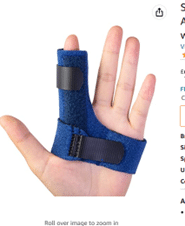What is the treatment?
Trigger finger may get better without any treatment. Try reducing the strain on this joint, and avoid activities that cause pain.
Soulagement de la douleur
Medication (such as simple painkillers or anti-inflammatories) may be useful. A pharmacist or your GP can help advise you what to take if needed. You can find further information here on what medications you could take here:
Comment et quand prendre du paracétamol pour les adultes - NHS (www.nhs.uk)
Ibuprofen pour les adultes : un analgésique qui traite également l'inflammation - NHS (www.nhs.uk)
Thérapie par la glace ou la chaleur
La chaleur peut être utile pour soulager les articulations raides et douloureuses. Essayez de remplir un bol d'eau chaude ou de poser votre main sur une compresse chauffante passée au micro-ondes pendant 10 minutes. N'utilisez pas la chaleur si votre articulation est chaude et gonflée, car cela pourrait l'aggraver. Utilisez plutôt une poche de glace ou un sachet de petits pois congelés.
Placez un torchon sur votre poignet (pour protéger votre peau des brûlures dues à la glace), puis placez une poche de glace ou un sachet de petits pois surgelés sur la zone douloureuse. Laissez agir pendant dix minutes et utilisez cette méthode jusqu'à trois fois par jour.
- Soyez prudent dans l'utilisation de la glace si vous avez des sensations altérées ou des problèmes circulatoires.
- Vérifiez régulièrement la peau et arrêtez si vous ressentez une douleur ou un picotement excessif.
Exercices pour les mains
General movement of the hand and thumb can be beneficial to maintain range of movement and prevent stiffness.
Attelles
 Sometimes wearing a splint at night may help to relieve the symptoms. A hand therapist can fit a splint for you if they feel this will help, or you can source one of these yourself like the one pictured below.
Sometimes wearing a splint at night may help to relieve the symptoms. A hand therapist can fit a splint for you if they feel this will help, or you can source one of these yourself like the one pictured below.
If your symptoms do not resolve, speak to your healthcare practitioner. A hand therapist may be able to help. They can help advise you as to the best management of your trigger finger and provide you with an individual tailored programme. They may make a splint to wear during the day if your symptoms are more severe.

 Sometimes wearing a splint at night may help to relieve the symptoms. A hand therapist can fit a splint for you if they feel this will help, or you can source one of these yourself like the one pictured below.
Sometimes wearing a splint at night may help to relieve the symptoms. A hand therapist can fit a splint for you if they feel this will help, or you can source one of these yourself like the one pictured below.